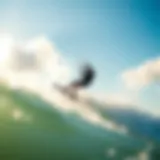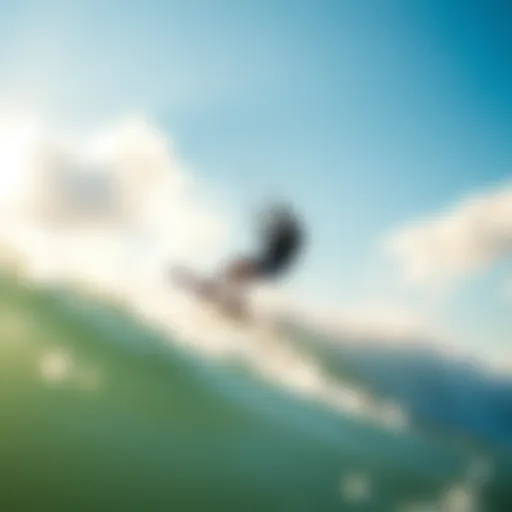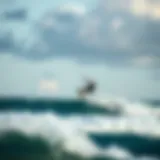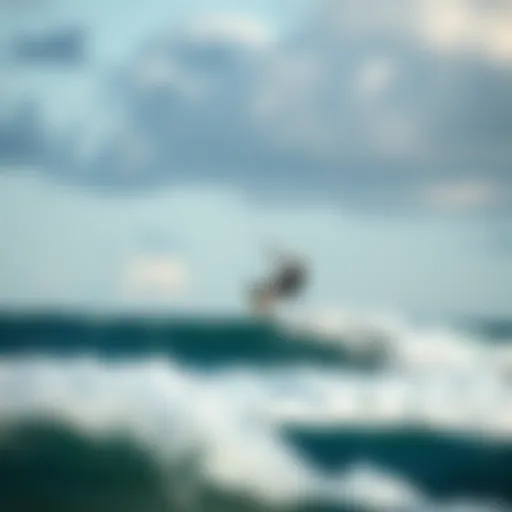Kiteboarding in Punta Cana: A Comprehensive Guide
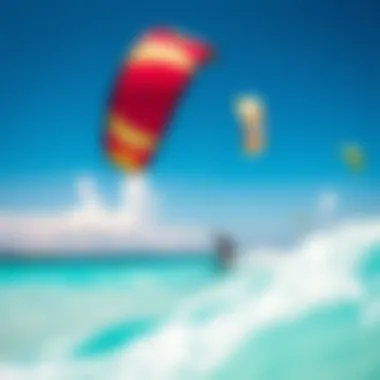
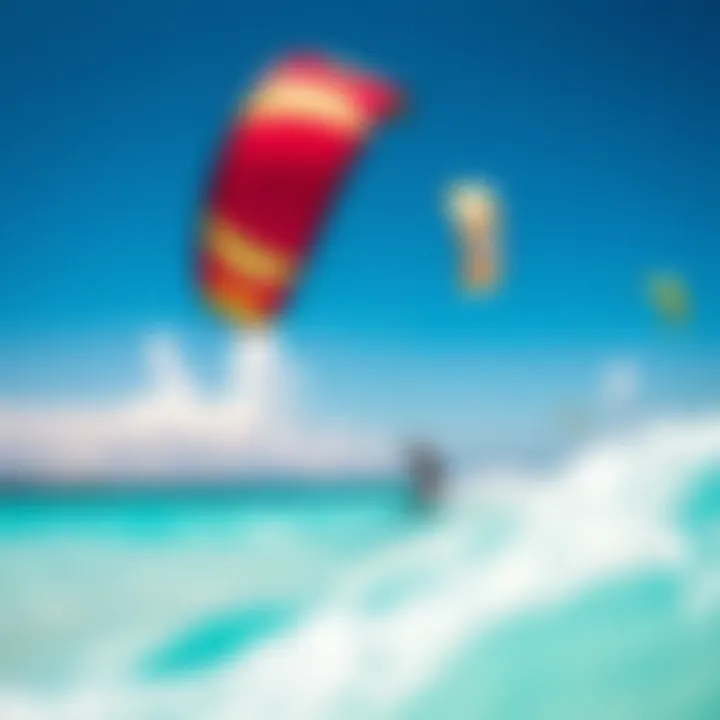
Intro
Punta Cana is often hailed as a tropical paradise, but for kiteboarding enthusiasts, it stands out for another reason. This region is blessed with ideal wind patterns, expansive beaches, and a vibrant community that stands ready to welcome both beginners and experts alike. Here, the turquoise waters and consistent breezes create an exhilarating environment for those wishing to take to the skies with a kite.
Kiteboarding combines elements of surfing and paragliding, providing riders a unique experience that blends skill with pure enjoyment. Whether you're just starting or looking to refine your advanced techniques, Punta Cana's spots are an ideal place to engage with the sport. In this article, we will delve into the techniques required, the equipment that suits various skill levels, and local resources that help shape the kiteboarding community.
The ability to glide across water, powered by the wind pulling a kite, might sound magical, but it is backed by techniques that anyone can learn with proper guidance.
Join us as we embark on an exploration of kiteboarding in this magnificent locale, aiming to elevate your skills and enjoyment on the water.
Understanding Kiteboarding
Kiteboarding combines the thrill of surfing, windsurfing, and paragliding, creating a sport that is both exhilarating and challenging. As we dive into this article, it is crucial to understand what kiteboarding entails and how this sport has evolved over time to become a key water activity, particularly in vibrant locations like Punta Cana. Grasping the fundamental elements of kiteboarding not only enhances the appreciation of the sport but also allows enthusiasts to engage more meaningfully with the kiteboarding community.
Definition and Overview
Kiteboarding, also known as kitesurfing, involves riding on a board while being pulled by a kite that is powered by wind. The experience is akin to being harnessed in the air and gliding across the water's surface, where the interaction between the kite and the wind creates the propulsion needed to maneuver effectively. In simpler terms, it is riding on water with the aid of a powered kite that acts as a means of propulsion.
The essential components of this sport include the kite, the board, and safety equipment. Each of these elements plays a significant role in maneuverability and control. With different types of kites and boards on the market, selecting the right gear can make or break one's experience, especially for novices. Understanding the types of kites—such as inflatable, foil, or hybrid—and selecting the right board based on skill level can significantly enhance the adventure.
While kiteboarding can seem daunting at first glance, its accessibility has made it increasingly popular among thrill-seekers. Schools and instructors are making efforts to simplify the learning process through structured lessons and safety protocols.
The Evolution of the Sport
Kiteboarding is relatively young when compared to other water sports, with its roots tracing back to the late 20th century. The sport gained momentum in the 1990s, thanks to visionary enthusiasts who integrated kitesailing technologies into a form that provides more control and versatility. Back in the day, people utilized parachutes or kites to harness the wind while riding on surfboards. Over the years, innovations in technology led to the development of specialized kites and boards tailored specifically for this sport.
The commercial boom in kiteboarding is also tied to influences from coastal tourism. Places like Punta Cana have embraced kiteboarding as not just a sport but an essential component of their tourism offerings. Events, competitions, and gatherings now dot the calendar, attracting professionals and newbies alike. Moreover, there is a growing culture centered around kiteboarding, fostering community bonds among practitioners.
In recent years, environmental considerations have prompted the kiteboarding community to focus on sustainability. As more people flock to beautiful coastlines, there is a shared responsibility to protect marine ecosystems. This evolution reflects not only the growth of a sport but a maturation in the mindset of its participants, encouraging sustainable practices amid thrilling adventures in the water.
Kiteboarding has transformed from a niche pastime into a global phenomenon, characterized by its blend of adrenaline, community, and a respect for nature's beauty.
As we embark on the journey through this article, we will explore the many facets of kiteboarding in Punta Cana—its geographical advantages, prominent spots, essential gear, and beyond—crafting a complete picture for those eager to ride the winds.
Punta Cana: A Prime Location
Punta Cana stands out as a premier location for kiteboarding, drawing enthusiasts from all corners of the globe. Various factors converge here that make the experience remarkable and, in many ways, unparalleled. The mix of suitable geography, climate, and wind patterns build a vibrant backdrop that supports both novice and experienced kiteboarders alike.
Geographical Advantages
One of the key elements that set Punta Cana apart is its geography. Nestled on the easternmost tip of the Dominican Republic, Punta Cana boasts a coastline adorned with sprawling white-sand beaches and azure waters. This unique layout not only provides stunning views but also ensures that the water stays relatively flat, creating favorable conditions for kiteboarding.
- Proximity to the sea: You can find spots just a stone's throw away from resorts and accommodations, making it easy to gear up and hit the water without wasting valuable time.
- Natural windbreaks: The abundance of coastal vegetation and shallow reefs offers some protection from stronger winds, which helps create more manageable conditions for riders.
- Diverse water conditions: From flat lagoons to mild waves, the variety present can cater to different skill levels and preferences, keeping the sport fresh and exciting.
Climate Considerations
Punta Cana enjoys a tropical climate that stays warm year-round. This consistent temperature is a boon for kiteboarding enthusiasts. The average yearly temperature hovers around 25-30 degrees Celsius. Here are a few climate highlights:
- Sunny Days: With more than 300 sunny days a year, there is a high probability of good kiteboarding conditions.
- Sea Temperature: The water typically stays around 26 degrees Celsius, making it comfortable for long sessions on the board.
- Rainfall: Rain can happen but usually comes in short bursts, so you’re not likely to have your entire day spoiled by the weather.
Wind Patterns Throughout the Year
Understanding wind patterns is essential for kiteboarders, and Punta Cana doesn’t disappoint in this area either. The trade winds generally blow from the east, with strength varying by season. Here's a brief breakdown of what you can expect:
- Summer (June to August): Consistent winds between 14-20 knots; perfect for both beginners and seasoned pros.
- Winter (December to February): The winds tend to pick up slightly, averaging 15-25 knots, providing excellent conditions for more advanced maneuvers.
- Fall/Spring Transition: These periods can be unpredictable but still offer manageable and thrilling kiteboarding experiences.
"Having reliable wind conditions throughout the year makes Punta Cana an attractive stop for kiteboarders looking to sharpen their skills or simply enjoy the sport."
In summary, with its geographical benefits, favorable climate, and consistent wind patterns, Punta Cana offers everything that kiteboarders—whether just starting or honing advanced techniques—could wish for. A visit here is likely to inspire a deep appreciation for the sport, alongside memories that could last a lifetime.
Popular Kiteboarding Spots in Punta Cana
Punta Cana, known for its striking shoreline and ideal kiteboarding conditions, attracts enthusiasts from every corner of the globe. The region's sun-soaked beaches not only provide a stunning backdrop but also some of the best spots for kiteboarding. Selecting the perfect location can greatly influence one’s overall experience. For kiteboarders, the right spot can mean the difference between a thrilling ride and a frustrated afternoon. The mix of water conditions, wind patterns, and overall atmosphere contributes to the kiteboarding experience, making each of these spots unique.
Bavaro Beach
Bavaro Beach stands as a beacon for kiteboarders due to its consistent winds and shallow water. The vibrant atmosphere makes it a hotspot among both novices and pros. This beach, with its soft, white sand and crystal-clear waters, sets the stage for breathtaking views against the backdrop of colorful sunsets.
Bavaro’s culture is lively. A medley of cafes and shops line the beach, creating a dynamic environment. Before or after a kiteboarding session, one can grab a local bite at a nearby eatery or shop for essential gear at local stores. The community here promotes a culture of sharing tips and sharing experiences, making it easy for beginners to blend in with seasoned riders. Plus, the availability of rental gear and lessons ups the convenience factor quite a bit.
"Bavaro Beach is not just a kiteboarding site; it’s an experience in itself. The joyful ambiance blends perfectly with the thrill of riding waves."
Macao Beach
Macao Beach, with its mesmerizing landscapes, offers a different experience, favored for its larger waves and more challenging conditions. Known for fewer crowds, this beach attracts those looking for a less commercialized atmosphere. This somewhat hidden gem provides access to winds that can vary significantly, making it a place where kiteboarders can test their mettle.
The sandy expanse offers ideal setups for beginner lessons, ensuring that novice sailors feel safe while they learn. For advanced kiteboarders, Macao's thrilling conditions present opportunities to tackle bigger challenges. It's worth noting that this beach also fosters a close-knit community, where locals are eager to share their love for the sport and may even join unsanctioned competitions.
Cap Cana
Cap Cana, often deemed the crown jewel of Punta Cana, exemplifies luxury and adventure. This area boasts stunning views and top-notch amenities, making it a favorite among serious kiteboarders and those seeking a splash of sophistication. The consistent trade winds create a playground for all skill levels, from beginners who can practice with confidence to advanced kiteboarders slicing through the waves.
The beach offers an expanse of clear water and perfectly sanded shores, making it a picturesque spot. The proximity of upscale resorts means that accommodations are never far away, and many establishments cater specifically to water sports enthusiasts, offering package deals that include kiteboarding lessons.
For kiteboarders who value a bit of luxury with their thrill, Cap Cana provides a perfect balance of excitement and comfort. Furthermore, the local schools are known for their rigorous standards and quality instruction, ensuring that anyone looking to refine their skills receives top-tier guidance.
Each of these kiteboarding spots in Punta Cana presents its own flavor and challenges. Whether it's the vibrant community at Bavaro Beach, the hidden allure of Macao Beach, or the luxe excitement of Cap Cana, there's something for everyone in this paradise. Choosing the right location not only enhances the kiteboarding experience but also contributes to a deeper appreciation of the environment and the culture surrounding the sport.
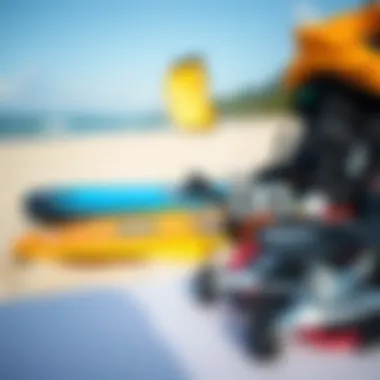
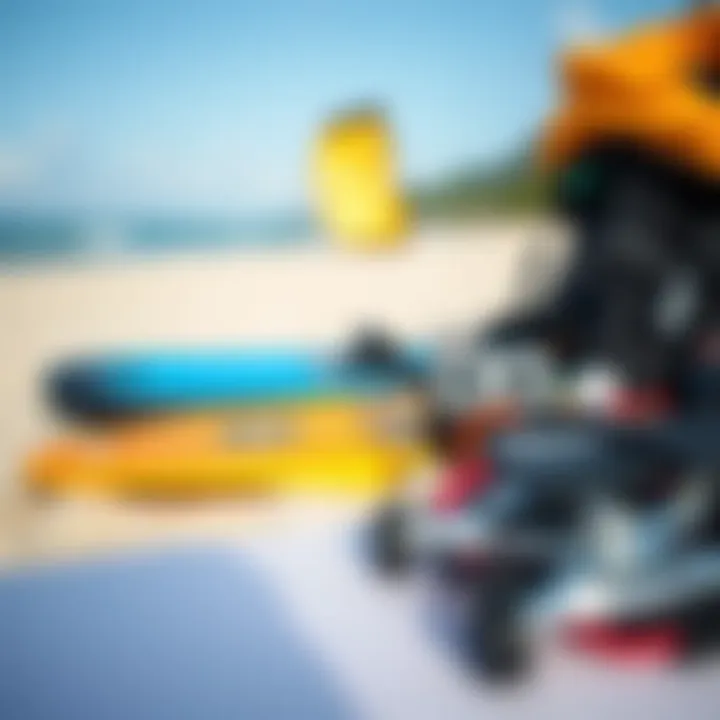
Essential Equipment for Kiteboarding
When it comes to kiteboarding, having the right equipment can make all the difference between a thrilling experience and a frustrating one. Essential gear is not just a collection of items but a lifeline that enhances safety, performance, and overall enjoyment of the sport. From the kites that harness the wind to the boards that you glide on, each piece plays a pivotal role in ensuring that beginners and seasoned kiteboarders alike can ride the waves skillfully.
Kites: Types and Selection
Selecting the right kite is crucial for performance and safety. Different types of kites are tailored for distinct wind conditions and rider experience levels. Generally, there are two main categories:
- Inflatable Kites: These are the most common, equipped with inflatable bladders that give them shape and stability. Ideal for beginners and high-performance riders, they handle a wide range of wind conditions and provide excellent lift.
- Foil Kites: These are more advanced and have a unique wing-like design that allows them to fly in lighter wind conditions. Foil kites are suitable for experienced riders, as their handling requires a keen understanding of wind dynamics.
Factors to consider when choosing a kite include:
- Wind Range: Ensure the kite can handle the wind conditions in Punta Cana, known for its steady breezes.
- Size: Kites come in various sizes; larger kites generate more power but can be harder to control in strong winds.
- Skill Level: Beginners are often recommended to start with a smaller inflatable kite for better control.
Boards: Equipment Choices
The selection of a kiteboard is just as important as the kite itself. Boards can broadly be categorized into two types:
- Twin-Tip Boards: These are symmetrical and can be ridden in either direction. They are the go-to choice for beginners due to their ease of use.
- Directional Boards: These boards are designed for riding in one direction, similar to a surfboard. They are preferable for advanced riders and provide a different experience on the waves.
While selecting a board, consider the following:
- Material: Look for materials that offer durability and lightweight characteristics. Boards made from epoxy or carbon fiber tend to deliver the best performance.
- Riding Style: Different boards cater to various styles, whether freestyle, freeride, or wave riding. Choose according to your preferred approach to kiteboarding.
Safety Gear: What You Need
Safety should never be an afterthought when kiteboarding. Specific gear is essential for both your well-being and that of others on the water.
- Impact Vest: This provides extra buoyancy and protection during landings or mishaps. It's always better to be safe than sorry.
- Helmet: A helmet shields the head from potential impacts and is recommended for all riders, especially those trying new tricks.
- Wetsuit: In Punta Cana, the water is warm, but a wetsuit can provide protection from scratches or stings from marine life.
- Leash: This keeps your kite attached to your body, preventing it from flying away during an unexpected fall.
Adopting proper safety measures enhances not only individual security but also contributes to the larger kiteboarding community, fostering a culture of responsibility and respect.
"A kiteboarder's life is often determined by the equipment they choose, making the right selection a key step in mastering the sport."
In contact with the necessary links:
Punta Cana's thriving kiteboarding community and its remarkable conditions make having the right equipment ever more crucial. Understanding these essentials lays a solid foundation for both safe and enjoyable kiteboarding adventures.
Techniques for Beginners
The foundation of kiteboarding rests on the ability to master fundamental techniques. For beginners, these techniques are not just stepping stones; they are essential pillars that support one’s journey in the sport. Getting the hang of these basics can make the difference between a thrilling experience and a daunting challenge. Understanding the intricacies of kite control, launching, landing, and water starts ensures safety while also enhancing confidence.
Basic Kite Control
Kite control is the first step in your learning process, akin to learning to walk before you run. This practice involves understanding how to handle the kite in different wind conditions. To dive into it, one must familiarize themselves with the kite's movements and responses. One way to grasp this is through "the imaginary window".
Rather than thinking of the kite just flying overhead, visualize a window in the sky—this is your control zone. Keeping the kite in this zone helps in managing its power and helps in making smooth transitions.
Practicing the following points can enhance kite control:
- Practice on land before hitting the water. Use a trainer kite that is smaller and more manageable.
- Experiment with different wind speeds. Identify how the kite reacts to both light and strong winds.
- Learn to steer through the lines. Understanding how tension affects control is crucial; slack lines can lead to accidents.
This early focus on kite control sets the groundwork for a more enjoyable experience on the water.
Launching and Landing
Learning to launch and land a kite can often feel like juggling with both feet planted firmly on the ground. However, proper technique in these actions safeguards you and those around you.
Key points to keep in mind:
- Launch: Ensure that your kite is correctly positioned relative to the wind and that your lines are clear of obstructions. During launch, a clear communication with your partner is paramount. Call "ready" and "go" to synchronize your actions.
- Land: Just as essential as the launch, the landing should also happen with control. Use a landing zone that is free of obstacles and ensure the kite is at the edge of the wind window when you are ready to touch down.
Mastering these steps fosters a sense of clarity and safety, both crucial when learning to kiteboard.
Understanding Water Starts
Once you’ve mastered kite control, launching, and landing, the next hurdle is the water start. This is often where beginners face the most frustration, but understanding the mechanics involved can ease the transition.
A water start begins when the kite is overhead, and you’re face down in the water. From this position, it’s about shifting weight and building speed.
Here’s a simplified breakdown of the process:
- Position the kite: Float in the water, holding the bar to control the kite. Once it’s at 45 degrees, you’re set to start.
- Edge into the water: Point the board to where the kite pulls, allowing it to generate lift.
- Stand up: As you feel the pull of the kite, stand up swiftly while keeping your weight centered over the board.
This moment is magical—a blend of balance, timing, and a bit of faith. With enough practice, what once felt like an impossible illusion turns into a thrilling ride, and you’ll find yourself grinning under the sun.
Through dedicated practice of these beginner techniques, kiteboarding becomes not just a sport, but a flourishing passion that connects one to the wind, water, and sky.
Techniques for Intermediate and Advanced Boarders
Kiteboarding is a thrilling sport that elevates in complexity as one progresses from a novice to an experienced rider. For those who have mastered the basics, delving into intermediate and advanced techniques not only enhances your skills but also boosts your enjoyment on the water. This section aims to explore advanced maneuvers, tricks and stunts, as well as jumping techniques, enabling kiteboarders to push their limits and embrace the adrenaline that comes with skillful riding.
Advanced Maneuvers
Engaging in advanced maneuvers is crucial for an intermediate kiteboarder looking to refine his or her skills. These techniques often require a deeper connection with the kite and stronger control over the board. Understanding how to perform turns such as the downloop or carving turn can transform your riding experience.
- Downloop: This move involves aggressively steering the kite downwards while in motion, creating speed and power. It's essential to time it right to maintain control, as incorrect timing can lead to crashes or loss of balance.
- Carve Turns: Carving smoothly into a turn allows for maintaining speed and line tension, giving the feeling of slicing through the water. It often makes transitions more fluid and encourages a more dynamic style of riding.
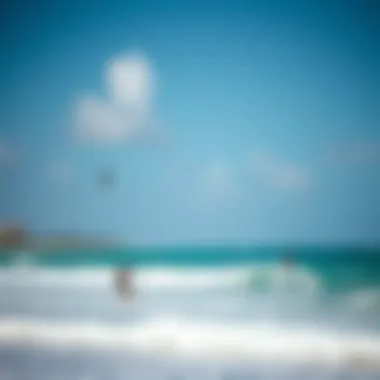
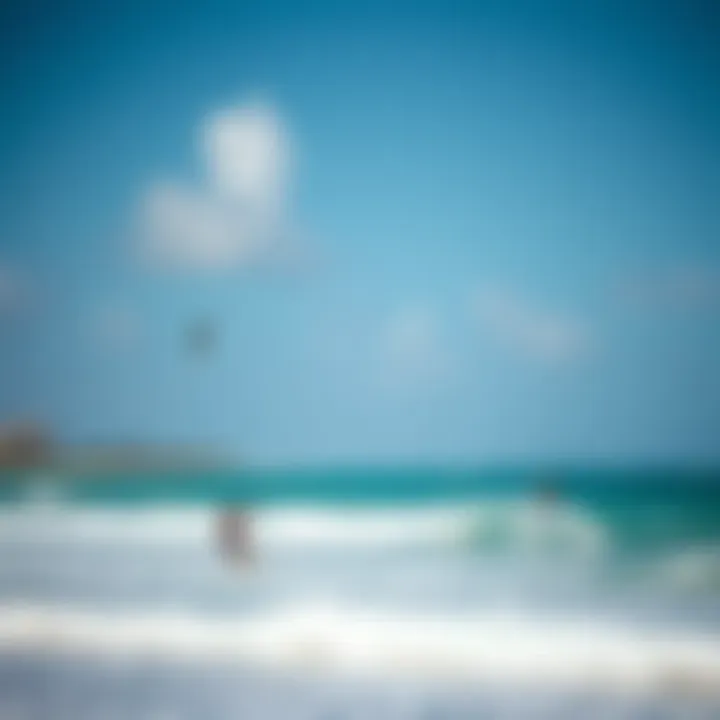
This is the moment where you make the kite dance with you—thrilling yet requiring precision.
Moreover, maneuvers like the kite loop can add flair to your sessions, but they require practice and commitment. A solid grasp of kite control is essential to execute these moves without losing balance.
Tricks and Stunts
Once the basics of kiteboarding are second nature, it’s time to sprinkle a bit of showmanship into your rides with various tricks and stunts. From simple rotations to complex aerial maneuvers, these techniques not only impress but also play a significant role in building confidence.
- Jumping: Every kiteboarder dreams of soaring above the waves. Start with simple tabletop jumps, where you extend your board while airborne. This helps in developing body awareness during aerial maneuvers.
- Rotations: Basic rotations like the 360° spin can dramatically improve your aerial skills. Practice by looking over your shoulder in the desired direction and steering the kite accordingly. Gradually increase the complexity with tricks like kombucha or handle passes.
These maneuvers build proficiency and thrill; the sense of accomplishment gained from successfully executing a stunt is irreplaceable.
Jumping Techniques
Jumping is perhaps one of the most exhilarating aspects of kiteboarding. It brings together timing, control, and understanding of the wind. To master jumping, kiteboarders must harness the right techniques, cultivating both courage and skill.
- Edge Control: Prior to take-off, effective edge control is paramount. By putting weight on the back foot and building speed, one can effectively load the board for lift-off.
- Kick Off: As your kite rises, push down with your legs while pulling the kite upwards. This action will provide the necessary lift and propel you into the air.
- Landing: The landing phase is just as important as take-off. Always look for the landing spot, and keep your knees bent to absorb the impact when touching down. The better your landing, the smoother your next take-off can be.
Local Schools and Lessons
The realm of kiteboarding, while exhilarating and rewarding, can also be quite the daunting venture for newcomers. Local schools in Punta Cana play a vital role in bridging this gap, providing accessible teaching and hands-on experience. They ensure not only skill development but also instill a strong foundation for safety and respect for the environment. Choosing a kiteboarding school that fits one's needs can influence the entire kiteboarding experience, turning a once intimidating activity into a fulfilling journey.
Overview of Kiteboarding Schools
Punta Cana boasts an impressive array of kiteboarding schools, each offering unique programs tailored to different skill levels. From established institutions like Kite Club Punta Cana to local gems such as Punta Cana Kite School, these establishments provide courses that range from complete beginner to advanced rider.
- Diverse Programs: Many schools offer packages that include theory lessons, practical sessions, and even advanced workshops.
- Qualified Instructors: Most local schools employ certified instructors who are experienced both in teaching and kiteboarding itself. This helps in ensuring a safe learning environment, where every student can thrive.
- Customizable Schedules: Flexibility is often a significant consideration; many schools allow students to choose lessons based on their convenience, with options for private tutoring or group sessions.
These schools act as hubs of information, sharing the current kiteboarding trends and local knowledge. Joining one not only facilitates skill acquisition but connects enthusiasts to the vibrant kiteboarding community in Punta Cana.
What to Expect in Lessons
For first-time kiteboarders, the prospect of lessons may come with questions about what they entail. Typically, kiteboarding lessons are structured to maximize both safety and enjoyment.
- Introduction to Equipment: Lessons usually begin with an overview of kiteboarding equipment. Students learn about the different types of kites, boards, and safety gear. Knowing how to handle equipment enhances comfort and confidence on the water.
- Assessment of Conditions: Understanding wind patterns and water conditions is crucial. Instructors often emphasize evaluating these aspects before beginning any session, creating a foundation for safe practice.
- Hands-On Practice: Lessons vary in duration but generally include significant hands-on training. Newcomers often spend a fair amount of time with land kiting, where they learn control before heading to the water.
- Emphasis on Safety: Safety protocols are ingrained in every lesson. Students are taught how to use safety gear effectively and understand emergency procedures. This focus helps instill a mindset of caution without dampening the spirit of adventurism.
Overall, kiteboarding lessons in Punta Cana promise a blend of education, excitement, and social interaction, enriching the entire experience.
Certification and Safety Standards
When engaging in kiteboarding, especially in a foreign location like Punta Cana, grasping the significance of certification and safety standards cannot be overstated. Various kiteboarding schools adhere to renowned international standards, ensuring students receive quality training.
- Accredited Programs: Many schools in Punta Cana follow standards set by organizations such as the International Kiteboarding Organization (IKO). These certifications ensure that the curriculum meets global benchmarks for safety and instruction.
- Skill Levels Certification: After completing a course, students often receive certifications that indicate their competencies. This not only boosts their credibility but can also open doors to further kiteboarding opportunities.
- Health and Safety Protocols: Kiteboarding schools maintain strict safety protocols. For instance, regular inspection of equipment and adherence to safe operating procedures are common practices.
This investment in quality education and safety ensures a rewarding experience, minimizing potential hazards associated with kiteboarding.
Safety Considerations
When kiteboarding in Punta Cana, safety should occupy a prime position in your thoughts. Kiteboarding, while exhilarating, comes with its share of risks. Understanding safety considerations can mitigate these risks and ensure a more enjoyable experience on the water. It's not merely about having fun; it’s about returning home in one piece. Navigating the ocean on a board towed by a kite demands respect for both the environment and your gear. Below, we will delve into two primary aspects: personal safety measures and environmental safety.
Personal Safety Measures
To maximize safety during your kiteboarding adventure, you must adhere to certain personal safety measures. These measures are not just guidelines; they are vital practices that protect you.
- Wear a Personal Flotation Device (PFD): A good-quality PFD can be a life-saver, and not just for the less experienced. It keeps you afloat in case of a mishap and is essential for everyone venturing out on the waves.
- Helmet Usage: Accidents can happen. A helmet shields your head from unexpected impacts, especially during the learning phase or when attempting new tricks.
- Check Your Gear: Before heading out, ensure that your equipment is in good working order. Look for any signs of wear and tear. One loose strap or a minor tear in your kite can lead to serious trouble.
- Buddy System: Kiteboarding is generally more fun with friends, but it’s also safer. Having a buddy allows for quick assistance in emergencies. Look out for one another.
- Know Your Limits: It’s easy to get carried away, especially with tempting conditions. Don't push beyond your skill level. Weather changes can drastically affect conditions, even in the prettiest waves.
"Safety isn't just a set of rules; it's the foundation of a good kiteboarding experience."
Environmental Safety
Kiteboarding can impact the local ecosystem, especially in areas like Punta Cana where nature is abundant. Mindful practices not only protect the environment but also enhance your experience on the water. Here are key points:
- Respect Wildlife: Always be aware of marine life in the area. Avoid areas known for nesting birds or sensitive habitats. Your presence should not disturb wildlife.
- Stay In Designated Areas: Many locations have designated kiteboarding zones. Staying within these areas helps protect delicate ecosystems and ensures the safety of all water users.
- Leave No Trace: It’s simple; pack out what you pack in. Dispose of waste properly and do not litter. Respect the beautiful environment that makes Punta Cana so appealing.
- Environmentally Friendly Gear: Consider using gear made from sustainable materials. Some brands are focusing on eco-friendly practices that reduce harm to marine environments.
Overall, being mindful of both personal safety and environmental considerations ensures that kiteboarders can enjoy their passion without compromising safety standards or contributing to ecological harm. Kiteboarding in Punta Cana can be an unforgettable experience, as long as all involved make a concerted effort to prioritize safety.
Community and Culture of Kiteboarding in Punta Cana
The culture surrounding kiteboarding in Punta Cana extends beyond just the sport; it creates a vibrant community that thrives on shared passions. Those drawn to the wide blue expanse of the sea and the thrill of riding the wind form connections that deepen the experience. Kiteboarding here is not merely an activity, it embodies a lifestyle embraced by enthusiasts who cherish camaraderie and the thrill that comes with the sport.
Local Events and Competitions
In Punta Cana, kiteboarding is alive and well with numerous events and competitions throughout the year. These gatherings serve as a showcase for both amateur and seasoned kiteboarders. Events like the Punta Cana Kite Fest draw local talent and international competitors alike. Participants can enjoy the exhilaration of competition and learn from the exciting displays of skill and creativity. It’s a chance for kiteboarders to put their techniques to the test, while spectators get an up-close look at top-notch performances in the heart of a breathtaking setting.
The vibe of these events is festive, where music, food, and a spirit of togetherness satellite around the main acts. Kiteboarding schools often bring their students to participate, allowing beginners to step out of their comfort zones and learn from seasoned riders. Informal competitions and friendly challenges frequently arise, nurturing the local spirit of friendly rivalry.
Building a Kiteboarding Network
Creating a solid network within the kiteboarding community stands to benefit all involved. Local shops, schools, and riders share the same beach and the same love for kiteboarding. Being part of this community means having access to vital resources, knowledge, and support. Making connections with instructors can lead to crucial insights, mentoring opportunities, and even partnership in events or trips.
Social media platforms and specialized forums serve as excellent meeting points for sharing experiences and advice. Examples include discussions on techniques, equipment recommendations, and favorite spots to practice. The bond formed among kiteboarders often transcends training routines as friendships deepen through shared experiences, discussions over kite setups, or even post-session chill-outs at local eateries.
Environmental Impact and Sustainability
The discussion around environmental impact and sustainability is becoming ever more critical, especially for activities like kiteboarding that directly interact with natural ecosystems. As kiteboarding grows in popularity, it’s imperative to focus on how this exhilarating sport can coexist harmoniously with the environment. Throughout this section, we’ll analyze its influence on local habitats and outline sustainable practices that can be adopted by enthusiasts. Being mindful of our surroundings not only enhances the kiteboarding experience but ensures future generations can also enjoy these beautiful locales.
Impact on Local Ecosystems
Kiteboarding, while thrilling, can pose risks to the delicate balance of local ecosystems, especially in a biodiverse region like Punta Cana.
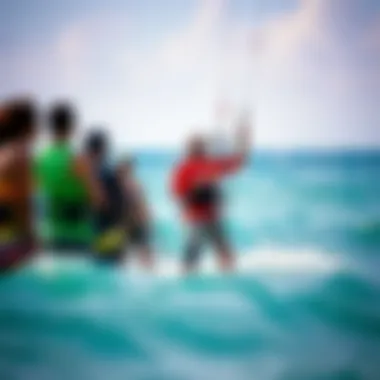
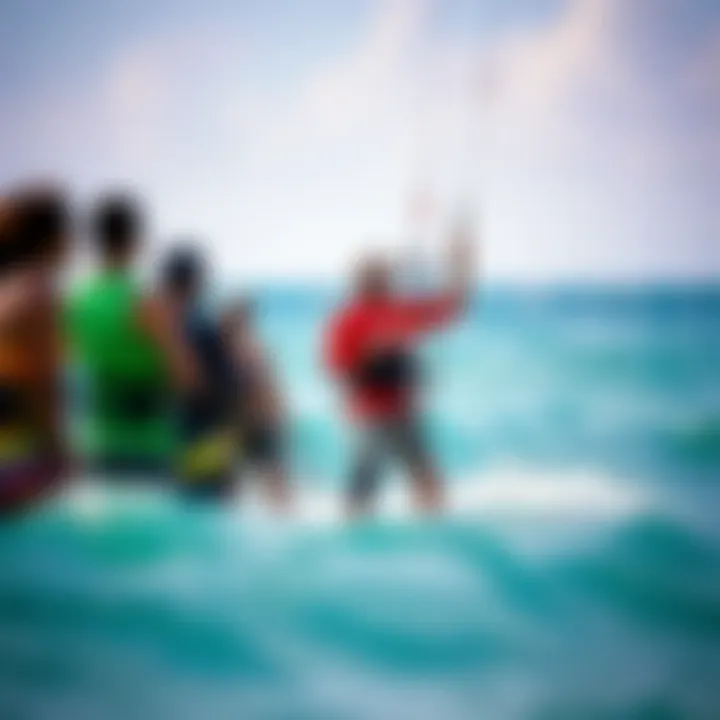
- Wetlands and Marine Life: The areas surrounding Punta Cana often feature shallow marine environments that provide essential habitats for various fish species and other marine life. Frequent kiteboarding activities can disturb these habitats, leading to unintended consequences. A careless rider might inadvertently damage coral reefs or disrupt nesting sites for local wildlife.
- Water Quality: The sport can also impact water quality. When kiteboarders launch and land their kites near sensitive areas, they may inadvertently stir up sediment or pollutants, harming fish and other organisms. Keeping in mind the cleanliness of the sites we enjoy is paramount.
"Sustainable usage of our natural resources is not just a responsibility but a necessity for continued enjoyment of such breathtaking locations."
- Interaction with Wildlife: It’s not uncommon to see seabirds and other wildlife along the shores where kiteboarding takes place. Engaging in the sport during key breeding seasons or close to nesting areas can disturb these species, leading to declines in their populations. Respecting local guidelines and nature’s cycle can alleviate this pressure.
By recognizing how our actions affect local ecosystems, kiteboarders can take strides to reduce their impact while still enjoying the thrills of the sport.
Sustainable Practices in Kiteboarding
Embracing sustainability while enjoying kiteboarding doesn’t have to be an uphill battle. Here are some effective practices that can make a significant difference:
- Educate Yourself and Others: Understanding the local environment can foster respect and protection for it. Sharing knowledge about the importance of preserving marine habitats can encourage fellow kiteboarders to be more mindful.
- Choose Sustainable Gear: Many brands are beginning to prioritize eco-friendly materials in their equipment production. Using kites made from recycled materials or boards that feature sustainable manufacturing processes contributes to reducing the environmental footprint of the sport.
- Follow Local Guidelines: Always adhere to local regulations regarding kiteboarding in sensitive areas. These guidelines are often established for good reason, aimed at protecting ecosystems and ensuring that the natural beauty is preserved for everyone.
- Limit Multiple Activities in One Spot: Try not to crowd the same area with multiple activities. Instead, diversify and explore different locations to limit disturbance to any single ecosystem.
- Practice Leave No Trace: Kiteboarding generates excitement, but with that comes responsibility. Clean up after yourself, dispose of waste properly, and avoid leaving any gear or trash behind.
Engaging in kiteboarding sustainably means recognizing that we are privileged to enjoy the beauty that nature offers. Applying these practices doesn’t diminish the thrill; in fact, it might deepen our connection to the environment around us.
Technical Advancement in Equipment and Techniques
The realm of kiteboarding is not simply about two elements— a kite and a board. It’s a dynamic sport that undergoes continuous evolution, bringing forth technical advancements in equipment and riding techniques. Understanding these advancements can greatly benefit kiteboarders, whether you are just starting out or have years under your harness.
Innovations in Kite Technology
Over the years, innovations in kite technology have transformed the way kiteboarders operate on water. The materials used in kites have evolved dramatically. Modern kites often utilize high-performance fabrics like ripstop nylon, which are not only lightweight but also durable.
Moreover, the introduction of bridled kites allows for a better lift-to-drag ratio, providing riders with enhanced performance and maneuverability. Riders can experience a wider wind range, allowing them to ride in lighter winds without losing control.
Kite designs have branched out as well. For example, the difference between delta kites and bow kites plays a substantial role in performance. Delta kites are favored for their stability and ease of launching, while bow kites are known for their powerful depower capabilities.
"Equipment is as important as skill; innovations can open new doors for both beginners and seasoned riders."
Additionally, the incorporation of technology in focusing on safety improvements cannot be overlooked. Safety systems have become more reliable, reducing risks significantly. These advancements include quick-release mechanisms and safety lines that prevent dangerous situations, allowing riders to focus on mastering their skills rather than worrying about equipment reliability during intense rides.
The Future of Kiteboarding
Looking ahead, the future of kiteboarding appears promising, propelled by ongoing developments in technology. As sensitized to sustainability as today's world is, eco-friendly materials that minimize environmental impact are likely to become more prevalent in kiteboarding gear. Innovations such as biodegradable kites and sustainable production methods could appeal greatly to environmentally-conscious riders.
Furthermore, the integration of digital technology into kiteboarding is on the horizon. Imagine kites equipped with sensors that provide data on wind patterns and best riding techniques in real-time. Enhanced smartphone apps could aid in tracking progress and analyzing performance, raising the bar for recreational and competitive kiteboarders alike.
Collaboration between kite manufacturers and technology companies could revolutionize training methods as well. Virtual reality experiences may soon imitate real-life scenarios, allowing learners to practice safely on land before hitting the water. This approach could tailor learning experiences based on individual progress, ensuring that every rider receives a personalized curriculum.
Planning Your Kiteboarding Trip
When it comes to enjoying kiteboarding in Punta Cana, planning is half the battle. A well-structured trip sets the stage for a satisfying experience that caters to both the seasoned rider and the novice looking to catch their first wind. Everyone wants to maximize their time on the water, and knowing when to go, where to stay, and how to get around can make all the difference. This section will dive into the essential elements for planning a successful kiteboarding venture in this picturesque paradise.
Best Times to Visit
Timing can transform your kiteboarding experience from simply good to absolutely unforgettable. For those seeking the ultimate kiteboarding conditions, the months between December and April are often heralded as the prime season. The winds blow consistently, averaging 15 to 25 knots, which is ideal for various skill levels. Each month carries its unique charm:
- December to February: These peak months see cooler temperatures and strong winds, perfect for thrilling rides.
- March and April: As the weather warms up, conditions remain excellent, making it a favored time for kiteboarders.
However, keep in mind that the off-season, which runs from May to November, shouldn't be dismissed outright. While winds can be less consistent, this period offers the opportunity to enjoy less crowded beaches and potentially lower accommodation prices.
Accommodations for Kiteboarders
Finding a suitable place to rest your head after a long day of kiteboarding is integral. Punta Cana boasts a wide array of accommodations catering specifically to kiteboarders and watersport enthusiasts. Opt for places that are situated near to the beaches where kiteboarding is popular, such as Bavaro Beach or Macao Beach. Some recommendable options include:
- Kiteboarding Resorts: There are numerous resorts that cater specifically to kiteboarders, providing direct access to the water and offering specialized amenities.
- Vacation Rentals: More affordable and offering flexibility, vacation rentals can place you right amongst local kiteboarding hotspots.
- Hostels: For the budget traveler, hostels can be a great way to save money while still forging connections with fellow kiteboarders.
Look for accommodations that offer easy access to lessons or equipment rentals.
Transportation Options
Navigating around Punta Cana can be a breeze with the right transportation options. Since kiteboarding spots can be spread out, evaluating your transport choices is key to enjoying your time:
- Rental Cars: A rental will provide the most freedom to explore hidden beaches and spots you might want to kiteboard at.
- Taxis or Ride-Sharing: Convenient for quick trips, though can add up if you have daily excursions planned. Using reliable apps can also save you hassle when travelling late.
- Bicycles: Some travelers find biking to be an enjoyable way to traverse the coastal areas and get around various spots with ease.
Above all, make sure to assess the proximity of your accommodations to the kiteboarding spots you intend to visit. As the journey plays a significant role in your overall experience, having a solid plan for getting about will ensure more time on the water and less time worrying about logistics.
End: The Allure of Kiteboarding in Punta Cana
Kiteboarding in Punta Cana is more than just a thrilling water sport; it’s a conjuring of elements—wind, water, and a robust community all nestled in the heart of paradise. The charm of this location is not merely in the breathtaking views or the ideal climatic conditions, but also in the sense of freedom it offers to anyone willing to strap on a board and take to the waves. As we wrap up this exploration, it’s crucial to highlight several factors that contribute to the allure of kiteboarding here.
The Essence of the Experience
Among the various elements discussed in detail, the environment stands paramount. The geographical advantages of Punta Cana, with its consistent wind patterns, create the perfect playground for kiteboarders of all levels. Visit during the windy season and you’ll understand why this region is often referred to as a kitesurfing mecca. Seeing dozens of colorful kites dotting the azure skies is more than just a visual treat; it’s a symbol of the vibrant kiteboarding culture that thrives here.
The rich tapestry of local culture merges seamlessly with the sport, inviting kiteboarders not just to ride the winds but to engage with the community as well. Attending local competitions or simply mingling with fellow enthusiasts at the beach fosters an atmosphere where friendships are born, and stories are shared. This social interconnectedness adds a layer of enjoyment that’s often overlooked in other locations.
Practical Considerations and Opportunities
When planning a kiteboarding trip, it’s essential to bear in mind practical considerations. The options for accommodations are plentiful, ranging from budget-friendly to luxurious resorts. Each caters to the distinct preferences of kiteboarders, ensuring that everyone can find a suitable spot to relax after a day on the water. Plus, with a plethora of kiteboarding schools providing lessons and gear, newcomers can dive right into the experience without feeling overwhelmed. It’s an easy entry point for those who want to learn in a supportive environment.
However, kiteboarding is not without its risks. The safety considerations outlined in previous sections shouldn’t be forgotten. Learning about personal safety measures and environmental hazards is just as important as honing one’s skills on the board. A well-prepared kiteboarder is often the happiest one.
The Unmistakable Appeal
"To kiteboard in Punta Cana is to dance with the wind—quite literally—giving you a taste of freedom that few other sports can offer."
As you wrap up your kiteboarding journey, consider reflecting on your experiences, both on and off the water. What did you learn? How did the culture impact your view of the sport? Ultimately, every ride is not just about conquering the waves; it’s about embracing a lifestyle that celebrates freedom, connection, and the sheer joy of the sport.
Resources for Further Exploration
- For gear recommendations and reviews, visit Reddit Kiteboarding
- To find schools and lessons, check Facebook Kiteboarding Punta Cana Groups
- Wikipedia on Kiteboarding
- Additional safety tips can be found at U.S. Coast Guard Guidelines
The beauty of Punta Cana combined with the thrill of kiteboarding creates an experience that lingers long after the last kite is packed away. It's an adventure that beckons to be relived, year after year.
